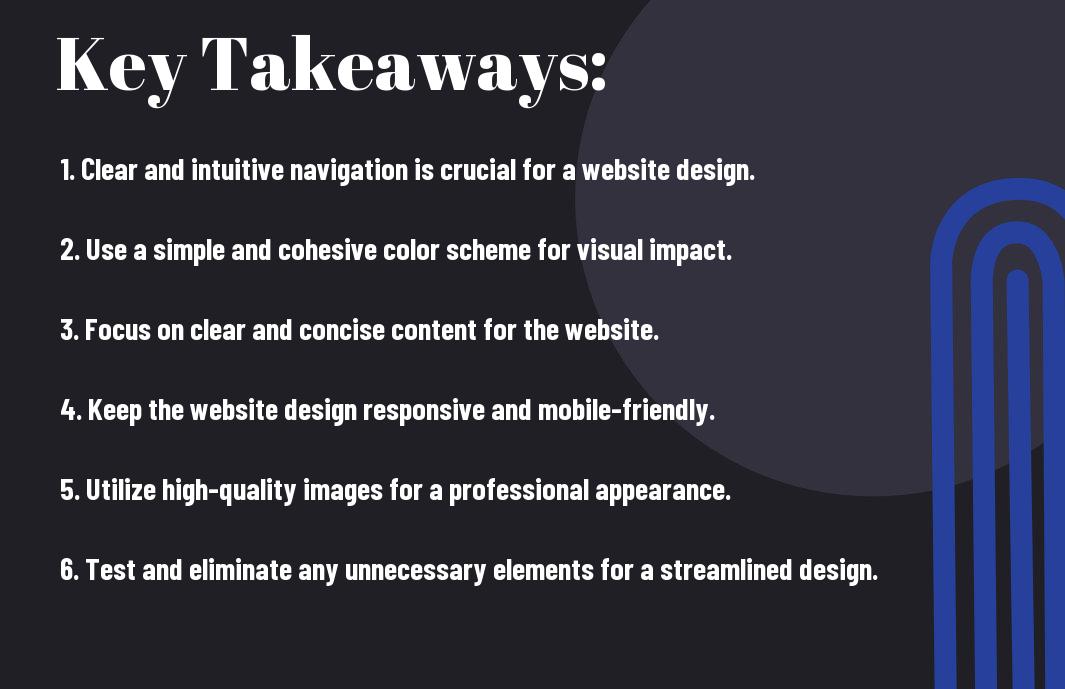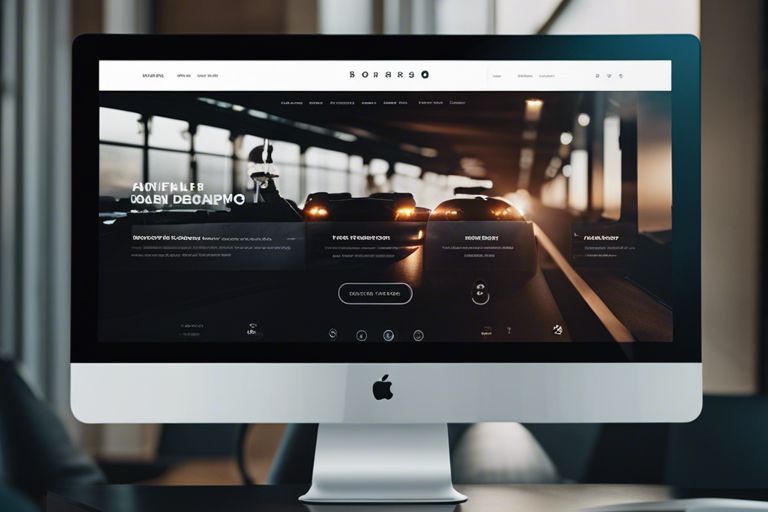Are you looking to enhance your online presence with a website that is not only visually appealing, but also easy to navigate and highly functional? In today’s digital age, having a well-designed website is crucial for any business or individual looking to make an impact online. Creating a simple and effective website design is essential for attracting and retaining visitors, as well as converting them into customers or clients. In this blog post, we will provide you with the necessary tips and techniques to create a website design that not only looks great, but also serves its purpose effectively. From choosing the right color scheme and layout to optimizing for mobile devices and usability, we will guide you through the process of creating a website that will impress and engage your audience. Stay tuned for expert advice and actionable steps to take your website design to the next level.
Key Takeaways:
- Simplicity is key: Keep the design clean and uncluttered to ensure a user-friendly experience.
- Effective navigation: Make it easy for users to find what they are looking for by implementing simple and intuitive navigation.
- Mobile responsiveness: Ensure that your website design is optimized for mobile devices to reach a wider audience.
- Consistent branding: Use consistent colors, fonts, and imagery to create a cohesive brand identity across the website.
- Clear call-to-action: Encourage user interaction by incorporating clear and prominent calls-to-action throughout the website.

Understanding Your Audience
Obviously, one of the most crucial factors in creating a simple and effective website design is understanding your audience. You need to know who will be visiting your website, what their needs and preferences are, and how they will interact with the content you provide.
Identifying Target Users
When identifying your target users, you need to consider demographic information such as age, gender, location, and income level. But don’t stop there. You also need to understand your users’ behavior, preferences, and motivations. By creating user personas and conducting user research, you can gain valuable insights into the specific needs and expectations of your target audience.
Tailoring Design to User Needs
Once you have identified your target users, it’s crucial to tailor your website design to meet their needs. This involves creating a user-centered design that focuses on providing a seamless and intuitive user experience. Incorporating features such as clear navigation, responsive design, and easy accessibility to information will ensure that your audience can easily find what they are looking for and have a positive interaction with your website.

Design Fundamentals
Despite the vast array of website design trends and techniques, there are certain fundamental principles that remain constant and essential to creating an effective website. To learn more about these design basics, you can check out this comprehensive guide on how to design a modern website (in 9 simple steps).
Layout and Navigation
When it comes to website design, a clear and well-structured layout is crucial for guiding users through your site. Your navigation menu should be prominently displayed and easily accessible, allowing visitors to find what they need quickly and efficiently. A cluttered and confusing layout can frustrate users and lead to high bounce rates, so it’s important to prioritize an intuitive and user-friendly design. Additionally, a responsive layout that adjusts to different screen sizes is essential for ensuring a positive user experience across various devices.
Color Scheme and Typography
The color scheme and typography of your website play a significant role in shaping its overall appearance and impacting user perception. When choosing a color palette, consider the emotions and associations that different colors evoke, as well as the contrast and readability of your chosen color combinations. Additionally, your typography should be legible and complement the overall design of your site. By maintaining consistency in your choice of fonts and colors, you can create a cohesive and visually appealing website that effectively communicates your brand identity.
Chapter 3: Creating Content
Now that you have the structure of your website in place, it’s time to focus on creating compelling content. Effective content is vital for engaging your audience and conveying your message clearly.
Effective Copywriting
When it comes to effective copywriting for your website, it’s important to keep it concise and compelling. You want to grab the attention of your visitors and communicate your message in a clear and concise manner. Use powerful headlines and engaging subheadings to break up the text and make it easier for your visitors to consume the information. Be sure to highlight the most important details and use persuasive language to encourage action from your visitors.
Incorporating Multimedia Elements
Incorporating multimedia elements, such as images, videos, and infographics, can greatly enhance the visual appeal of your website. Visual content not only makes your website more visually appealing, but it also helps to convey information more effectively. You can use high-quality images and videos to showcase your products or services, as well as infographics to present data in a visually engaging way. Just be sure to optimize your multimedia content for fast loading times to ensure a smooth user experience.
By incorporating effective copywriting techniques and multimedia elements into your website, you can create a compelling and engaging experience for your visitors. Remember to focus on the benefits of your products or services, and use visuals to complement your message. Your content should instill trust and credibility in your audience while motivating them to take action.
Testing and Launching
Your website is almost ready to go live, but before you launch, it’s crucial to ensure that everything is functioning as it should. You want to create a positive user experience for your visitors, and that means conducting thorough testing and finalizing any remaining details. For a comprehensive guide on website testing and launching, check out How to Design a Website | 8 Easy-to-Follow Steps.
Pre-Launch Checklists
Before you launch your website, it’s important to go through a pre-launch checklist to ensure everything is in place. Check for broken links, test the website across different devices and browsers, review and optimize page loading speed, and verify that all forms and contact information are functioning correctly. It’s also essential to proofread all content for spelling and grammar errors, ensure that SEO elements are in place, and that your website’s security features are all set up properly. Taking the time to go through a thorough pre-launch checklist will help minimize the risk of any issues once your website is live.
Post-Launch Analytics and Feedback
Once your website is live, it’s time to start monitoring its performance using analytics tools. You can track visitor behavior, engagement, and conversion rates to gain valuable insights into how users are interacting with your website. Additionally, encourage feedback from users to understand their experience and identify any areas for improvement. This data will help you make informed decisions to improve your website’s performance and enhance the user experience, ensuring that it continues to meet the needs of your audience.
Maintaining Your Website
Keep your website in top shape by ensuring it is regularly maintained. From security updates to ongoing optimization for search engines, regular maintenance is crucial for the health and performance of your website.
Regular Updates and Security
Regular updates and security maintenance are essential for your website’s security and performance. Keep your website platform, plugins, and themes updated to the latest versions to ensure that any security vulnerabilities are patched. Hackers often exploit outdated software, so it’s crucial to stay on top of updates. Additionally, consider implementing strong security measures such as regular backups and SSL certificates to protect your website from potential security threats.
SEO and Ongoing Optimization
SEO (Search Engine Optimization) is an ongoing process that involves optimizing your website to improve its visibility in search engine results. Regularly updating your website with fresh, relevant content and optimizing it for targeted keywords can help improve your website’s ranking. Pay attention to on-page SEO elements such as meta tags, titles, and descriptions, as well as off-page factors such as backlinks and social signals. Ongoing optimization is crucial to ensuring that your website remains competitive in the ever-changing landscape of online search.
Conclusion: How to Create a Simple and Effective Website Design
Hence, creating a simple and effective website design is crucial for attracting and retaining visitors to your site. By following the steps outlined in this guide, you can ensure that your website design is user-friendly, visually appealing, and optimized for performance. Remember to keep your design clean and uncluttered, prioritize user experience, and make sure your website is mobile-responsive. Additionally, regularly updating and maintaining your website will help keep it fresh and relevant to your audience. By implementing these principles, you can create a website design that effectively communicates your brand and message, and ultimately improves your online presence.
FAQ
Q: What are the key elements of a simple and effective website design?
A: The key elements of a simple and effective website design include a clean and organized layout, easy navigation, clear call-to-action buttons, and a visually appealing color scheme and typography.
Q: How can I create a visually appealing color scheme for my website?
A: To create a visually appealing color scheme for your website, consider using complementary colors, sticking to a limited color palette, and paying attention to the psychological effects of different colors on your audience. Tools like Adobe Color and Coolors can also help you generate color schemes.
Q: What is the best approach to organizing the layout of a website for simplicity and effectiveness?
A: The best approach to organizing the layout of a website is to focus on a clean and uncluttered design, prioritize important content above the fold, use negative space effectively, and make sure that all elements are visually balanced and aligned with each other.
Q: How can I ensure easy navigation on my website for users?
A: To ensure easy navigation on your website, create a clear and consistent menu structure, use breadcrumbs to show users their location on the site, and provide search functionality. Additionally, make sure that all links are easily clickable and that the website is responsive across different devices.
Q: What are some effective ways to optimize the performance of my website?
A: To optimize the performance of your website, consider using a content delivery network (CDN) to improve loading times, compressing images to reduce file sizes, minifying CSS and JavaScript files, and using caching techniques. It’s also important to regularly review and update your website’s content to ensure its relevance and accuracy.


